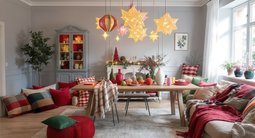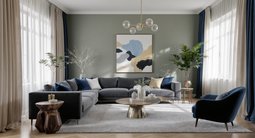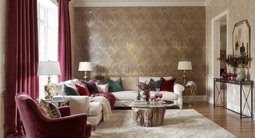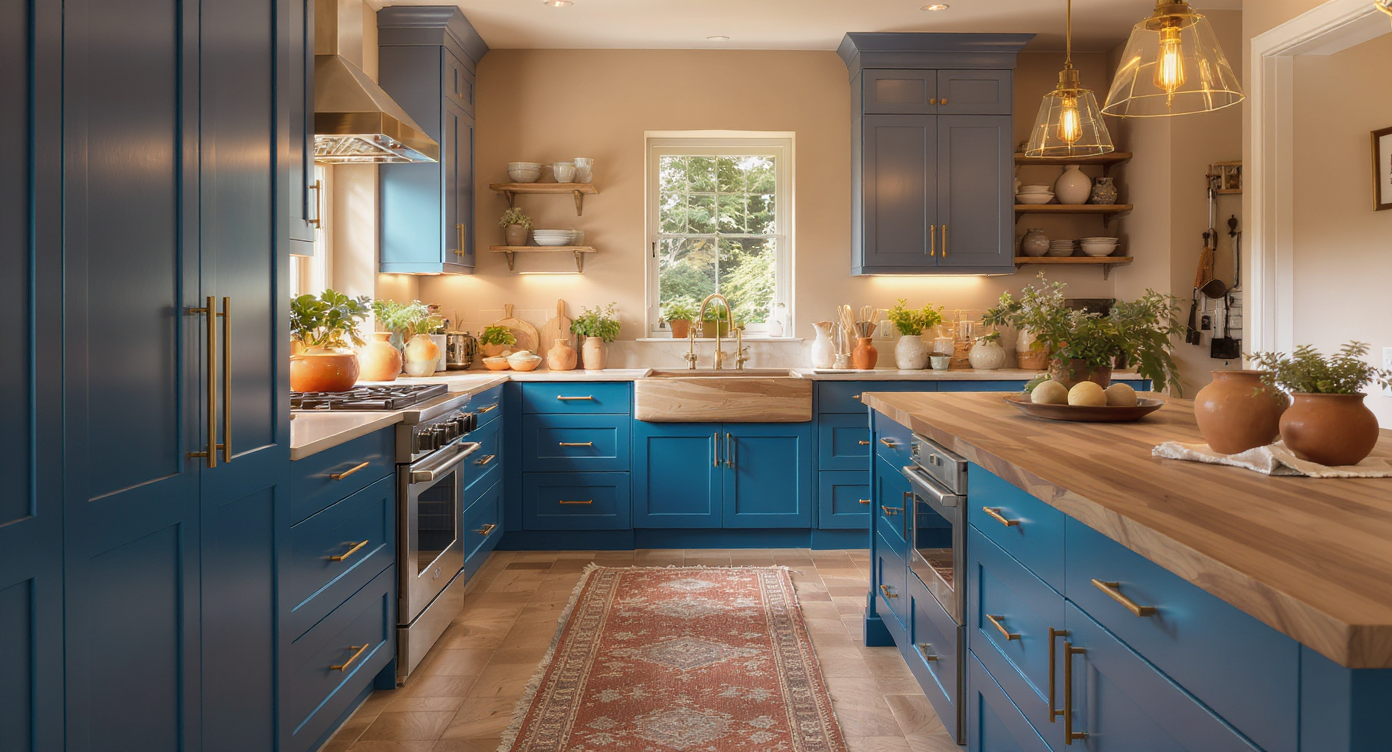TL;DR
Quickest win: switch to 2700–3000K, 90+ CRI bulbs, add a vintage runner, and swap nickel for brass. For how to warm up a blue kitchen, layer in wood, terracotta, and soft ochre walls before you consider repainting cabinets or changing flooring.
A cool kitchen in a warm house? Here’s how to make it flow

Focus on lighting and materials to transition a cool blue kitchen into a warm, cohesive space.
A cool kitchen in a warm house? Here’s how to make it flow
Start with the fundamentals: lighting temperature, metal finishes, and tactile materials will change how a blue kitchen reads long before paint or demo does. Experts often advise addressing light first, then layering color and texture so the room connects to adjacent spaces.
In a Victorian or character-rich home where mustard, marigold, or terracotta live nearby, a cool kitchen can feel like a pause. The good news is you can bridge it quickly. In the first 100 dollars, focus on kitchen lighting and brass hardware; in the next 500, add a runner rug, wood accents, and a warm wall color. The result is a warm kitchen that still celebrates those beautiful blue cabinets.
The fastest ways to warm up a blue kitchen
Core Strategy: the fastest ways to warm up a blue kitchen
The single biggest mood shift comes from swapping bulbs to 2700–3000K with 90+ CRI, then layering under-cabinet task lights for evening glow and clarity.
1) Dial in kitchen lighting
Use 2700–3000 Kelvin for cozy ambient light, and aim for 35–50 lumens per square foot for general lighting and 70–100 for task zones. Designers often advise choosing high CRI (90+) so woods, brass, and textiles look rich instead of gray.
If you have cool, blue-white fixtures, even a perfect paint color will read cold. Try dim-to-warm LED bulbs and a simple dimmer for instant softness at night.
2) Swap hardware to brass or warm bronze
Changing nickel to brushed brass or warm bronze adds instant warmth and ties to terracotta and mustard palettes. For pulls, 5–8 inch center-to-center sizes feel modern on drawers; 3–4 inches suits smaller doors.
Match sheen to the story: unlacquered brass ages beautifully in older homes; satin brass stays consistent and smudge resistant in busy kitchens.
3) Add wood, terracotta, copper, and amber glass
Natural materials visually warm a cool palette in minutes. A trio of walnut cutting boards, a terracotta utensil crock, a copper kettle, and an amber glass bottle will harmonize with blue cabinets and stainless appliances.
Group items in threes and vary heights for an unfussy, collected look that reads intentional, not cluttered.
4) Warm the envelope with the right wall color
For blue cabinets, soft ochre, clay, camel tan, or muted mustard on walls create a cozy bridge to nearby terracotta or marigold rooms. Experts recommend satin or washable matte for cleanability in kitchens.
Considering navy walls? In small or low-light kitchens they can feel heavy; where natural light is strong, a deep blue with a warm undertone can look luxe. Test swatches from light to dark corners before committing.
5) Use a runner to calm busy floors and add warmth
A 2.5x8 or 3x10 runner adds comfort, color, and texture while breaking up cool or patterned tile. Keep 36–42 inches of walkway clearance and add a 1/8 inch rug pad for safety.
Look for vintage-style rugs with rust, brick, clay, and saffron notes that echo your dining and living spaces.
6) Tidy the details: trim, shelves, and backsplashes
Paint any floating white cabinet trim or "crown" to match the blue so it stops reading as a cold stripe. Designers often advise color-matching add-ons to avoid visual chop.
On a micro-budget, line glass cabinet interiors with grasscloth-style adhesive or paint the backs a dark clay to add depth. If you plan future work, a warm stone or terracotta tile floor is a beautiful long-term upgrade.
One homeowner insight: start with bulbs and a runner; live with it two weeks. Most people find 70 percent of the "warmth" they wanted before lifting a paintbrush.
Anecdote
A homeowner swapped twelve cool bulbs for 2700K LEDs, laid a 3x10 runner with rust and ochre, and leaned two walnut boards by the range. The kitchen instantly matched the warmth of the adjacent terracotta living room without a single paint can opened.
Common mistakes when warming up a cool kitchen
Common mistakes when warming up a cool kitchen
Choosing 4000–5000K bulbs in a blue kitchen can undo every other warm detail; target 2700–3000K instead for a cozy, inviting tone.
- Going too dark, too fast. Deep navy walls can make a galley feel tight. Sample warm mid-tones first, especially in rooms with limited natural light.
- Mixing too many patterns. If floors or backsplashes are busy, keep walls and runners more grounded so the room doesn’t feel jittery.
- Matte paint in splash zones. Flat finishes are hard to clean. Use satin or washable matte around sinks and cooktops.
- Ignoring CRI. Even at 2700K, low CRI bulbs can mute wood and brass. Look for 90+ CRI to keep colors and materials vivid.
- Hardware mismatch. Random finishes look accidental. Repeat brass or bronze in at least three touchpoints for cohesion.
Pro tips designers use to add warmth that lasts
Pro tips designers use to add warmth that lasts
Repeat one warm accent color at least three times at eye level to knit the palette together without repainting cabinets.
- Bridge the rooms. Pull mustard or terracotta from adjacent spaces into the kitchen via art, textiles, and ceramics so the whole floor feels intentional.
- Follow a 60-30-10 color plan. Let soft neutrals be 60 percent, blue cabinetry 30 percent, and warm accents 10 percent for balance.
- Dim-to-warm layering. A small lamp on the counter plus under-cabinet strips creates a restaurant-soft glow after dark.
- Choose metals by mood. Satin brass feels crisp, unlacquered brass feels timeworn, oil-rubbed bronze reads rustic. They all warm blue.
- Smart sampling. Paint two 2x3 foot wall samples in the darkest and lightest corners. Check them morning, noon, and night under your target bulbs.
Personal reflection: almost every “cold kitchen” I visit stops feeling cold the minute warm light, wood, and brass show up. Paint and floors become Phase Two, not Day One.
Anecdotes, tools, and a warm-kitchen daydream
Anecdotes, tools, and a warm-kitchen daydream
Swapping twelve cool bulbs for 2700K LEDs and sliding down a 3x10 vintage runner took one homeowner 30 minutes and changed the whole mood. The cabinets didn’t move an inch, yet the space finally felt like part of the house.
Another client, a renter, replaced chrome pulls with satin brass and leaned a walnut cutting board behind the cooktop. Add a terracotta utensil crock and a copper teapot, and guests swore they had repainted.
A family in a sunny Victorian tested paint the thoughtful way: they tried a soft ochre on the sink wall and repainted the odd white cabinet trim to match the blue. The surgical vibe vanished; the kitchen started to glow alongside their terracotta living room.
And for a long-game upgrade, one couple floated peel-and-stick terracotta-look tiles over winter to preview the feel. Months later, they committed to real terracotta, and the blue cabinetry looked custom by contrast.
Tools, inspiration, or resources
- Lighting: 2700–3000K, 90+ CRI, dim-to-warm LEDs, under-cabinet strips, and a simple dimmer.
- Textiles: 2.5x8 or 3x10 runners, natural rubber pad, vintage or vintage-look patterns with rust, clay, and saffron.
- Paint and finishes: soft ochre, clay, camel tan in satin; unlacquered or satin brass hardware.
- Plan layouts or visualize palettes with ReimagineHome to preview wall colors, runners, and hardware finishes before committing.
Suggested image captions and alt text: “Blue cabinets with brass hardware and oak boards,” “Kitchen runner in rust and ochre,” “2700K under-cabinet lighting warming terracotta accents.”
Visualization
Picture this: morning light hits a camel-tan wall, a rust-and-saffron runner softens your steps, and a copper kettle warms on the stove. The blue cabinets feel calm, not cold. A cluster of walnut boards and an amber bottle glow under 2700K task lights. It smells like coffee and orange zest. It finally feels like home.
Visualization Scenario
At dusk, the under-cabinet lights glow amber, brass pulls catch the light, and a clay-colored runner grounds the floor. Blue cabinetry recedes to calm, while a camel wall and copper kettle add a friendly hum of warmth. The space feels timeless, not trendy.
FAQ
FAQ
What’s the best lighting temperature for a warm kitchen?
Use 2700–3000K bulbs with 90+ CRI for a cozy look that keeps colors accurate and materials rich. Add dim-to-warm under-cabinet lights for evening glow.
How should I warm up a blue kitchen without repainting cabinets?
Swap to brass hardware, change bulbs to 2700–3000K, add a rust or terracotta runner, and layer wood, copper, and amber glass on counters and shelves.
Should I paint kitchen walls navy or mustard with blue cabinets?
Mustard, ochre, or camel usually bridge better and feel cozier; navy can work in high natural light but may feel heavy in smaller or low-light kitchens.
What size runner is best for a galley kitchen?
Common sizes are 2.5x8 or 3x10, leaving 2–4 inches from baseboards and 36–42 inches of walkway clearance. Use a thin, non-slip pad for safety.
How do you choose brass hardware for blue cabinets?
Pick a consistent finish like satin or unlacquered brass and repeat it on at least three elements. Use 5–8 inch pulls on wide drawers and 3–4 inches on small doors.
Wrap-up
Wrap-up
Warmth is a sequence, not a sledgehammer. Start with lighting at 2700–3000K and 90+ CRI, add a runner, swap to brass, and bring in wood, terracotta, and soft ochre. If you still want more, paint walls, then consider flooring or backsplash later. That order gives you the biggest return for the least stress.
When you can try variations virtually, even better. Use a visualizer like ReimagineHome to test colors, runners, and metals until your cool kitchen and warm house feel like one story.




.svg)

.svg)



.png)